In the world of poker, particularly Texas Hold’em, the term “bad beat” has a specific connotation that resonates with players both new and experienced. While the phrase itself might evoke feelings of frustration and disappointment, it plays a significant role in the game, especially when it comes to understanding concepts like the bad beat pot. This article delves into the intricacies of what a bad beat pot is, its implications in poker games, and how it can affect player psychology and strategies.
Understanding the Basics of a Bad Beat
A “bad beat” occurs when a player with a statistically strong hand loses to another player who has a significantly weaker hand, often due to a lucky draw on the river (the final community card in Texas Hold’em). For example, imagine a scenario where Player A has a pair of aces, and Player B has a lower pair. As the community cards are revealed, Player B manages to hit a set (three of a kind), resulting in a surprising win. Player A may feel the sting of a bad beat, especially if they were heavily favored to win.
In many casinos, especially in cash games, a bad beat jackpot is set up to reward players who suffer such unfortunate losses. This is where the concept of a “bad beat pot” comes into play.
What is a Bad Beat Pot?
A bad beat pot is a special pool of money that accumulates in a poker game when a player loses with a strong hand to a player with a weaker hand. The rules for what qualifies as a bad beat can vary from casino to casino, but generally, the losing hand must meet certain criteria to be eligible for the jackpot.
How It Works
- Establishment of the Bad Beat Pot: A small portion of each pot is contributed to the bad beat jackpot. This is typically a fixed percentage, such as 1% of the pot, capped at a certain amount.
- Qualifying Hands: For a hand to qualify for the bad beat jackpot, the losing hand usually must be a certain minimum rank, such as four of a kind or a higher full house. If a player loses with this strong hand, they can claim a share of the jackpot.
- Distribution: When a bad beat occurs and qualifies for the jackpot, the losing player receives a substantial portion, while the winning player and potentially other players at the table also receive smaller shares. The exact distribution is predetermined by the house rules.
Example of a Bad Beat Pot Scenario
Consider a Texas Hold’em game where the bad beat jackpot is set up. Player A has a full house (aces over kings), and Player B holds four of a kind (four kings). Player A bets heavily, believing they have a winning hand. However, when the showdown occurs, Player B takes the pot, and Player A loses with what is statistically a strong hand.
Given the rules of the bad beat jackpot, Player A qualifies for a share, receiving a set amount, while Player B takes the main pot. Other players at the table might also receive a smaller percentage of the jackpot, depending on the casino’s specific rules.
Implications of a Bad Beat Pot
Player Psychology
Bad beats are an emotional rollercoaster for poker players. The existence of a bad beat pot can somewhat cushion the blow of losing with a strong hand, creating a sense of camaraderie among players who have experienced similar misfortunes. This camaraderie can lead to an environment where players feel more comfortable sharing their experiences and strategies, fostering a sense of community.
Strategy Adjustments
Knowing that a bad beat pot exists can also influence a player’s strategy. Some players might become more aggressive, trying to capitalize on the potential for a bad beat and hoping to either qualify for the jackpot themselves or to take advantage of players who are playing with a heightened sense of caution after experiencing a bad beat.
Conversely, the existence of the bad beat pot might lead some players to become overly cautious. They might tighten their ranges, opting to only play premium hands to avoid the emotional distress of losing a large pot, thus potentially impacting the game dynamics.
Financial Implications
From a financial perspective, the bad beat pot introduces an additional layer to the poker economy. It can entice players to join cash games or tournaments, knowing there’s a chance to win money even when they lose with a strong hand. This can increase overall action and, consequently, the amount of money in circulation at the table.
The Drawbacks of a Bad Beat Pot
Despite the excitement and camaraderie a bad beat pot can foster, it also has its drawbacks. Here are a few considerations:
Encouragement of Poor Play
One concern is that the bad beat pot might encourage players to play hands they otherwise wouldn’t, hoping to hit a bad beat and qualify for the jackpot. This can lead to more reckless play, where players chase unlikely draws or play marginal hands, negatively impacting the overall skill level at the table.
Increased Variance
The introduction of a bad beat pot can lead to increased variance in the game. Players may find themselves going through periods of bad luck, only to watch others hit bad beats and claim jackpot shares. This can be particularly disheartening for those who prioritize skill and strategy, as luck can play a larger role in determining outcomes.
Misunderstandings and Disputes
The rules surrounding bad beats can sometimes lead to misunderstandings among players, especially in home games where rules may not be clearly outlined. Disputes can arise regarding whether a hand qualifies for the bad beat jackpot, which can sour the experience for those involved.
Conclusion
In summary, a bad beat pot is a unique and often controversial aspect of poker that adds an interesting dynamic to the game. It serves as a safety net for players who experience the emotional and financial toll of losing with a strong hand. While it fosters community and can make the game more exciting, it also has potential downsides, including encouraging poor play and increased variance.
Understanding the concept of a bad beat pot can enhance your poker experience, whether you’re playing casually with friends or competing in a casino. By recognizing both the benefits and drawbacks, players can make more informed decisions about their strategies and approach to the game. Ultimately, poker is a blend of skill, strategy, and luck, and the bad beat pot is just one of the many factors that contribute to the rich tapestry of this timeless game.




